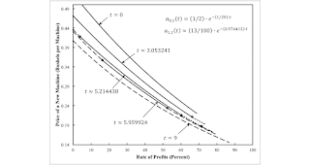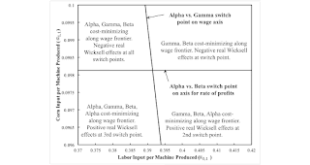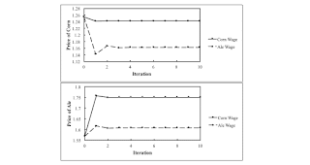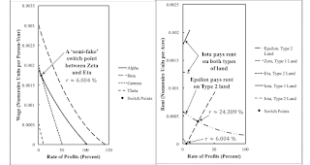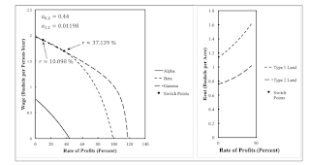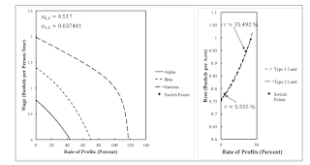Figure 1: Structural Economic Dynamics of the Price of a New Machine I am not sure that there is any great insight here. But this post depicts the evolution of prices in an example which I have been explaining in two posts. For some parameters, I have found that a shorter economic life of a machine may be associated with a more capital-intensive technique around a switch point. This can occur at both a 'normal' and a 'perverse' switch point. This finding raises difficulties for tradional...
Read More »Technological Progress In Industry And The Life Of A Machine In Agriculture
Figure 1: Variation of Switch Points with Technological Progress in Industry This post is an expansion on this post. Technological progress in industry, in which the machine is produced, can be illustrated in Figure 1 in the previous post by a movement roughly from off the graph to the upper right to below the lower left. More concretely, suppose each of the two non-zero coefficients of production in the machine industry decrease at a constant rate of σ0 and σ1 respectively. The two...
Read More »The Emergence Of Non-Monotonic Variations In The Economic Life Of A Machine
Figure 1: A Part of the Parameter Space1.0 Introduction This post presents a perturbation of an example from Salvatore Baldone. It follows the style of some posts that almost add up to a draft research paper. A widespread view among Austrian-school and mainstream economists is mistaken. Given competitive markets, if the supply of capital were increased, in some sense, the rate of profits would supposedly be driven down. At the level of abstraction here, no distinction exists between the...
Read More »A Iterative Procedure Converging To Prices Of Production
Figure 1: Prices of Corn and Ale in an Iterative Process1.0 Introduction Anwar Shaikh proposed, sometime in the 1970s, I guess, an interpretation of Marx's transformation problem. Marx's solution in volume 3 of Capital is the first step of an iterative process. I thought I might work through this idea with an example from an old exposition of mine. I am not sure how faithful I am to Shaikh's approach. I notice that as I explain it, the equality of total values and of total prices is...
Read More »Rate Of Profits As A Weighted Sum Of Value Rate Of Profits
1.0 Introduction Stefano Perri has a working paper, "Sraffa's response to Eaton's review: a note on the standard commodity and Marx's general profit rate". In this post, I present the analysis rewritten in matrix notation. The claim is, more or less, that the rate of profits in the system of prices of production is the weighted average of the rates of profits, by industry, in the system of labor values. Each weight is the product of the labor value of capital advanced in that industry and...
Read More »The Reswitching Of The Orders Of Fertility And Rentability Revisited
Figure 1: A Part of a Parameter Space This post revisits my numerical examples in which I demonstrate the possibility of the reswitching of the order of fertility and of the reswitching of the order of rentability. Each of those posts presents a numeric example. In each, different ranges of the coefficients of production a0,2 and a1,2 are considered. This post combines those ranges, while still not considering the full parameter space, even for the slice for these coefficients. In the...
Read More »An Example Of Non-Uniqueness In A Model Of Extensive And Intensive Rent
Figure 1: Wage and Rent Curves for a Numeric Example1.0 Introduction This post continues, with some repitition, my exposition of a model of extensive and intensive rent. In the example, the cost-minimizing technique is non-unique at a low enough wage or rate of profits. One cost-minimizing technique, Epsilon, illustrates a case of extensive rent. The other cost-minimizing technique, Iota, illustrates a case with both extensive and intensive rent. In this technique, a kind of absolute rent...
Read More »A Fluke Case For Extensive Rent
Figure 1: Wage Curves and Rent for an Example of Extensive Rent I more-or-less have a draft research article in five posts: post 1 post 2 post 3 post 4 post 5. I suggest that the current post can replace the fourth post. It is a variant on on this post. The analysis of the choice of technique in models of extensive rent can be based on the construction of wage curves, even though the outer envelope does not represent the cost-minimizing technique. The orders of fertility and rentability...
Read More »Reswitching Of The Order Of Fertility
Figure 1: An Example of the Reswitching of the Order of Fertility1.0 Introduction Nobody has ever pointed out the possibility highlighted by this post, as far as I know. This post can be contrasted with this one. Talk of "switch points" and "reswitching" for the wage curves on the left pane in Figure 1 above is, arguably, an abuse of terminology. Quantity flows do not change around the switch points. The same lands are fully farmed, and the same land that is partially farmed has the same...
Read More »Reswitching Of The Order Of Rentability
Figure 1: An Example of the Reswitching of the Order of Rentability1.0 Introduction Nobody has ever pointed out the possibility highlighted by this post, as far as I know. Talk of "switch points" and "reswitching" for the rent curves on the right pane in Figure 1 above is an abuse of terminology. Under capitalism, land obtains rent because land is scarce. The power of the state backs up individuals prohibiting others from using free gifts of nature. (Propertarians are about encouraging...
Read More » Heterodox
Heterodox

